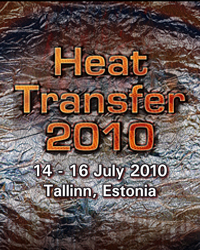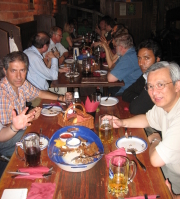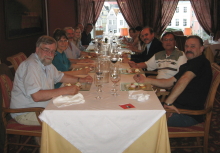11th International Conference on Heat Transfer
14 - 16 July 2010
Tallinn, Estonia
Overview
 The 11th International Conference on Heat Transfer has recently been held in Tallinn, Estonia, organised by the University of Tartu, Estonia, the Wessex Institute of Technology, UK, and the University of Lund, Sweden.
The 11th International Conference on Heat Transfer has recently been held in Tallinn, Estonia, organised by the University of Tartu, Estonia, the Wessex Institute of Technology, UK, and the University of Lund, Sweden.
The Co-Chairmen of the meeting were Professor Bengt Sunden from the University of Lund, Professor Ulo Mander from the University of Tartu and Professor Carlos Brebbia from the Wessex Institute of Technology.
Research and development of computational methods for solving and understanding heat transfer problems continues to be important because heat transfer topics are commonly of a complex nature and different mechanisms like heat conduction, convection, turbulence thermal radiation and phase change may occur simultaneously. Typically, applications are found in heat exchangers, gas turbine cooling, turbulent combustion and fires, fuel cells, micro and minichannels, electronic cooling, melting and solidification. Heat transfer may be regarded as an established and mature scientific discipline, but it has played a major role in new engineering areas such as sustainable development and reduction of greenhouse gases as well as for micro- and nano- scale structures and bioengineering. Non-linear phenomena other than momentum transfer may occur due to temperature-dependent thermophysical properties. In engineering designed development, reliable and accurate computational methods are required to replace or complement experienced time-consuming experimental trial and error work. Tremendous advancements have been achieved during recent years due to improved numerical solutions of non-linear partial differential equations, turbulence modelling and computer developments to achieve efficient and rapid calculations. Nevertheless, further progress in computational methods will require developments in the theoretical and predictive procedures - both basic and innovative – and in applied research. Accurate experimental investigations are required to validate the numerical calculations.
Opening Addresses
Professor Carlos Brebbia opened the conference welcoming the delegates in the name of the Wessex Institute of Technology (WIT). He explained some of the developments that have recently taken place in Ashurst Lodge. The objective of WIT, Professor Brebbia said, is to act as a catalyst for interaction between different partners around the world, aiming for the rapid transfer of technology. These activities are carried out through a comprehensive series of seminars, conferences and courses, and by the dissemination of the resulting material and other publications throughout the world in digital and paper format and by collaboration with many other institutions around the world. WIT has a large number of link agreements with other institutions and participates in several major EU interdisciplinary projects amongst others.
Professor Brebbia mentioned the success of the computational techniques developed by WIT, particularly the Boundary Element Method, which is now being extensively used in many practical emerging applications. A particular interesting case is that of electric field analysis to protect structures against corrosion. This allows for the design of cathodic protection systems for structures such as those in deep water in the Gulf of Mexico and other locations. Cathodic protection is one of the main current areas of industrial research at Ashurst Lodge.
The Wessex Institute of Technology, Professor Brebbia explained, welcomes visitors and is always happy to discuss ways for further collaboration with our academic and industrial colleagues.
Professor Ulo Mander welcomed the delegates in the name of the University of Tartu. He explained that Estonia is a small country but has retained its language and culture in spite of considerable ordeals. The University itself is located in the second largest city in the country and is a major part of the city’s activities.
The University of Tartu was established in 1632 by Swedish academics. It has now 17,000 students in eight faculties. Tartu itself is known to have existed at least 1,000 years ago.
Professor Mander works at the Faculty of Science and Technology, in the Institute of Ecology and Earth Sciences, and works in the field of Environmental Technology. Professor Mander is internationally renown for his work in wetlands and contamination problems, including those resulting from oil shale mining which is a major source of energy for Estonia. More than 95% of the electric power generation in Estonia is based on oil shale burning which produces a series of pollution problems.
Keynote Address and Invited Presentations
The conference technical sessions was opened by a Keynote Address by Professor Bengt Sunden , read by Professor R Amaro of the Mechanical Engineering Department, University of Wisconsin at Milawaukee. The topic was ‘On Internal Tip Cooling of Gas Turbine Blades’.
Other invited presentations were;
‘Rarefield gas flow and heat transfer in microchannels based on DSMC / CFD Simulations’
by Q Wang, State Key Laboratory of Multiphase Flow, China
‘Use of experimentation in the accurate numerical simulation of thermal processes’
by Y Jaluria, State University of New Jersey, USA
‘Peltier modules in cooling systems for electronic components’
by K Domke, Technical University of Poznan, Poland
‘Numerical methods for problems with moving interfaces and irregular geometries’
by J Chai, The Petroleum Institute, United Arab Emirates
‘Three-dimensional simulation of slip-flow and heat transfer in a microchannel using the lattice Boltzmann method’
by A Sousa, University of New Brunswick, Canada
Conference Sessions
The other papers were grouped into the following sessions;
- Multiphase Flow Heat Transfer
- Modelling and Experiments
- Natural and Forced Convection
- Radiation
- Heat Exchangers
- Advances in Computational Methods
Conference Dinner
There were ample opportunities during the conference for the delegates to meet outside of the formal sessions. In addition to the coffee breaks, they were offered complimentary lunches in the conference venue, and a special excursion to the University of Tartu was organized.
The banquet gave the participants another opportunity to interact in informal settings. It took place in the building belonging to one of the medieval trading fraternities which existed in Tallinn at the time. These fraternities were distributed throughout the port cities at the time of the Hanseactic League and located in large buildings where the merchandises were securely stored and the members could find lodgings. The one visited by the delegates is called the ‘Black Head’ and it’s distinctive motif is the head of St. Maurice. There they had dinner followed by a display of folkloric dances. At the end the participants were invited to join in the dance with carious degrees of success. The occasion was most enjoyable, created a nice atmosphere and helped to develop further contacts amongst the participants.
Excursion to the University of Tartu
During the afternoon of the second day of the conference the delegates were taken to Tartu, the ancient town where the University is located. There they were shown the new Campus including the modern buildings and laboratory where Professor Ulo Mander works, as well as the old University facilities in town including the main building, site of the Rectorate and the Aula Magna. This is of classical design dated from the beginnings of the XIX century and surrounded by elegant buildings of the same period. They also visited the old city square dominated by the Town Hall, the oldest in continuous use as such in Europe.
They ended in a typical Estonian restaurant located in the old walls of the city fortifications. The premises were an old gunpowder room built by the Russians and consisting of a vast open space with a high roof in the form of a painted arch; its shape so designed as to blow up in the case of an explosion. There they sampled typical Estonian dishes and the local beer, in a very friendly atmosphere.
The whole evening was very pleasant and helped to strengthen the links between delegates as well as giving them the occasion to see one the oldest Universities in the region, truly modernized and recently expanded.
International Scientific Advisory Committee

The members of the International Scientific Advisory Committee met over dinner to discuss reconvening the meeting in 2012 and the changes that could be made to improve the quality of the papers and make the contents of the conference of continuous relevance to the community. Several suggestions were discussed and new topics proposed. The general agreement was that the meeting was hugely successful and it is important to ensure its continuous improvement.
Publication of Papers
The proceedings of Advanced Computational Methods and Experiments in Heat Transfer XI, 352pp (Print ISBN: 978-1-84564-462-8; Online ISSN: 1743-3533) are available from WIT Press priced at £134/US$268/€188. Orders can be placed online at www.witpress.com or by email:
Papers from the conference will also be hosted online in the WIT eLibrary as Volume 68 of WIT Transactions on Engineering Sciences (ISSN: 1743-3533). For more details visit the WIT eLibrary at http://library.witpress.com


 Wessex Institute
Wessex Institute